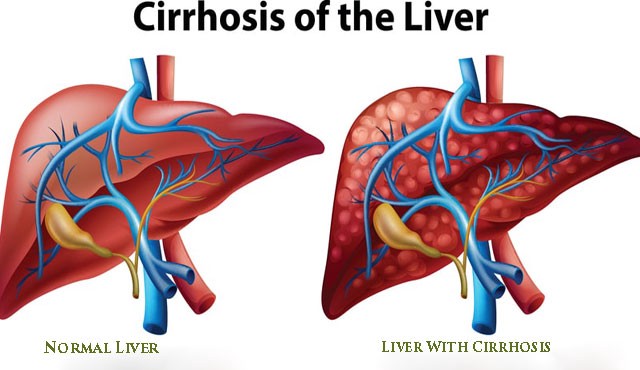Cirrhosis is a slowly progressing disease in which healthy liver tissue is replaced with scar tissue, eventually preventing the liver from functioning properly. The scar tissue blocks the flow of blood through the liver and slows the processing of nutrients, hormones, drugs, and naturally produced toxins. It also slows the production of proteins and other substances made by the liver.
According to the National Institutes of Health, cirrhosis is the 12th leading cause of death by disease.
What Causes Cirrhosis of the Liver?
Hepatitis C, fatty liver, and alcohol abuse are the most common causes of cirrhosis of the liver in the U.S., but anything that damages the liver can cause cirrhosis, including:
- Fatty liver associated with obesity and diabetes.
- Chronic viral infections of the liver (hepatitis types B, C, and D; hepatitis D is extremely rare).
- Blockage of the bile duct, which carries bile formed in the liver to the intestines, where it helps in the digestion of fats; in babies, this can be caused by biliary atresia in which bile ducts are absent or damaged, causing bile to back up in the liver. In adults, bile ducts may become inflamed, blocked, or scarred, due to another liver disease called primary biliary cirrhosis.
- Repeated bouts of heart failure with fluid backing up into the liver.
- Certain inherited diseases such as:
- Cystic fibrosis
- Glycogen storage diseases, in which the body is unable to process glycogen, a form of sugar that is converted to glucose and serves as a source of energy for the body
- Alpha 1 antitrypsin deficiency, an absence of a specific enzyme in the liver
- Diseases caused by abnormal liver function, such as hemochromatosis, a condition in which excessive iron is absorbed and deposited into the liver and other organs, and Wilson's disease, caused by the abnormal storage of copper in the liver
Although less likely, other causes of cirrhosis include reactions to prescription drugs, prolonged exposure to environmental toxins, or parasitic infections.
What are the Symptoms of Cirrhosis of the Liver?
The symptoms of cirrhosis of the liver vary with the stage of the illness. In the beginning stages, there may not be any symptoms. As the disease worsens, symptoms may include:
- Loss of appetite
- Lack of energy (fatigue), which may be debilitating
- Weight loss or sudden weight gain
- Bruises
- Yellowing of skin or the whites of eyes (jaundice)
- Itchy skin
- Fluid retention (edema) and swelling in the ankles, legs, and abdomen (often an early sign)
- A brownish or orange tint to the urine
- Light colored stools
- Confusion, disorientation, personality changes
- Blood in the stool / vomiting
- Fever
What is the Treatment for Cirrhosis of the Liver?
Although there is no cure for cirrhosis of the liver, there are treatments available that can stop or delay its progress, minimize the damage to liver cells, and reduce complications.
The treatment used depends on the cause of cirrhosis of the liver.
- For cirrhosis caused by alcohol abuse, the person must stop drinking alcohol to halt the progression of cirrhosis.
- If a person has hepatitis, the doctor may prescribe steroids or antiviral drugs to reduce liver cell injury.
- For people with cirrhosis caused by autoimmune diseases, Wilson's disease, or hemochromatosis, the treatment varies.
Medications may be given to control the symptoms of cirrhosis. Edema (fluid retention) and ascites (fluid in the abdomen) are treated, in part, by reducing salt in the diet. Drugs called diuretics are used to remove excess fluid and to prevent edema from recurring. Diet and drug therapies can help improve the altered mental function that cirrhosis can cause. Laxatives such as lactulose may be given to help absorb toxins and speed their removal from the intestines.
Liver transplantation may be needed for some people with severe cirrhosis.
How Can I Prevent Cirrhosis of the Liver?
There are several ways to reduce your risk of developing cirrhosis of the liver:
- Don't abuse alcohol. If you do drink alcohol, limit how much you drink and how often. Remember, it's not only the heavy drinker who gets cirrhosis. If you drink more than 2 drinks a day, you are increasing your risk. A drink is a 5-oz glass of wine, a 12-oz can of beer, or a 1 1/2-oz portion of hard liquor.
- Avoid high-risk sexual behavior such as unprotected sexual contact with multiple partners.
- Be careful around synthetic chemicals, such as cleaning products and pesticides. If you come into contact with chemicals often, wear protective clothing and a facemask.
- Get vaccinated against hepatitis B.
- Eat a well-balanced, low-fat diet high in fruits and vegetables and take vitamins.
- Maintain a healthy weight, because excess body fat can cause fatty liver, which may lead to liver disease.



